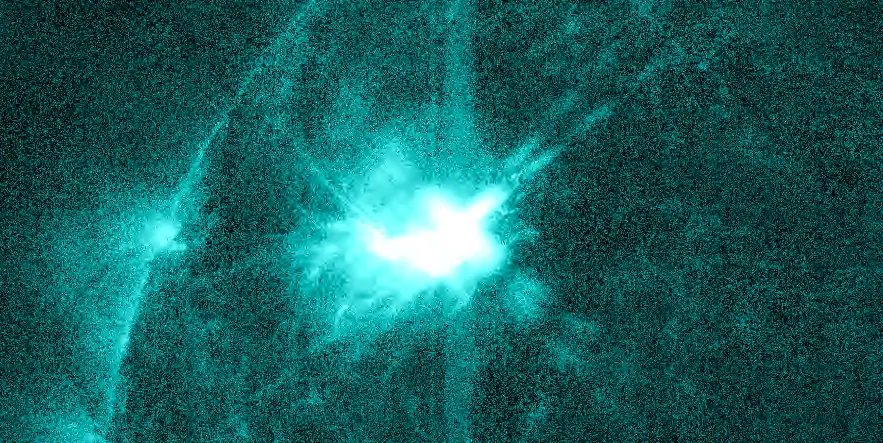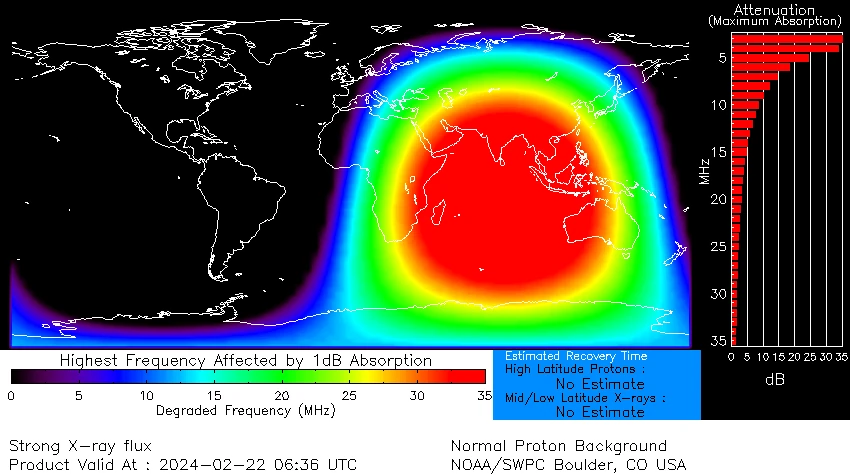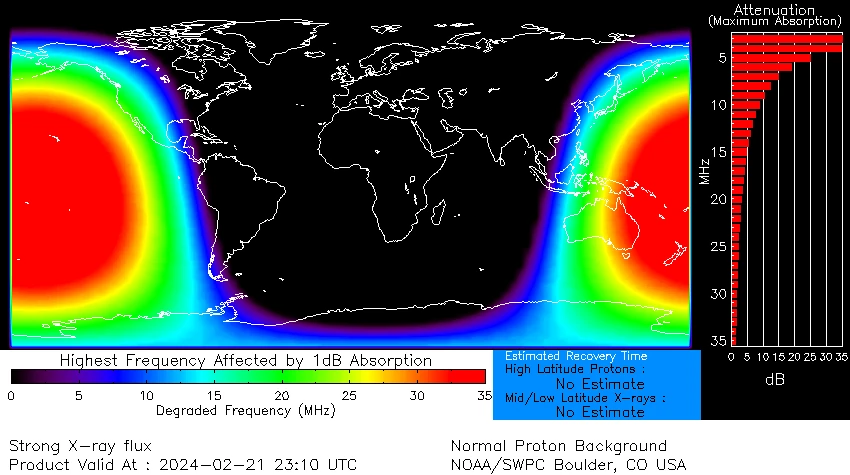Major network outages in U.S. following two X-class solar flares

A widespread network outage was reported in the United States on Thursday morning, February 22, 2024, following two major eruptions on the Sun, an X1.8 flare at 23:07 UTC on February 21 and X1.7 at 06:32 UTC on February 22. Both erupted from Active Region 3590.
The main question everyone in the space weather community was confronted with today is whether these flares could have affected the telecommunication networks in the United States, causing major outages.
These outages primarily affected cellular service, particularly for users of AT&T, with tens of thousands of their users reporting issues according to Downdetector.com. Other carriers like Verizon, T-Mobile, UScellular, and Cricket Wireless were also affected to a lesser extent.
The outages also affected companies like Starlink, Consumer Cellular, Boost Mobile, Google, US Cellular, Spectrum, Xfinity, OpenAI, Facebook, Microsoft and many others.
The impact was felt in major cities across the US, including San Francisco, Houston, Chicago, Los Angeles, New York, and Boston, causing disruptions to communication, internet access, and even emergency services in some areas. Most carriers reported full or partial restoration of service later in the day.
While there were reports of isolated incidents in other parts of the world around the same time, these seem to be unrelated to the US outage and were likely caused by localized issues with specific providers or infrastructure.
According to NOAA SWPC, solar flares can affect communication systems, radar, and the Global Positioning System, based on the intensity of the eruption and associated phenomena, but it is highly unlikely that these flares contributed to the widely reported cellular network outages.
Many solar astrophysicists agree. “Some people are attributing cell network outages (AT&T, Verizon) in the U.S to last night’s X-class solar flare. However, flares only cause radio degradation on the dayside of the Earth. As you can see below, the U.S was not affected by the event. So it’s just a coincidence,” said solar astrophysicist Dr. Ryan French.

While it’s true that radio frequencies were forecast to be most degraded over the Indian Ocean at the time of the X1.7 flare, the largest effects of the X1.8 event on February 21 (some 7 hours before the X1.7) were much closer to the United States, but still mostly over the Pacific Ocean.

Ben Davidson of the Suspicious Observers YouTube channel added an interesting connection, saying: “These networks are not connected to one another in such a way that we can easily blame something else [other than solar flares], including hacking. This broader scope makes NOAA’s claim of unlikely more and more unlikely to be accurate.”
“If it was hacking, it was a hacking effort on a scale never before seen on Earth and they timed it right when the solar blasts occurred. There can be no certainty either way at this moment but I do have to say that best and most reasonable explanation at this time is that the ionospheric and global electric circuit impact from the back to back X-class triggered these disruptions of the communication and infrastructure networks.”
“The part of Earth facing the Sun only matters for HF radio propagation,” Davidson added on X.
Whether you agree or not, it’s evident that only through our collective efforts can we devise meaningful solutions to the technical, economic, societal, and other challenges we face as they will only increase in the future.
There exists a significant gap between scientists holding academic degrees and citizen scientists, yet it’s imperative for both groups to collaborate closely and respect each other. Bridging this divide can unleash a wealth of untapped potential, combining the rigorous methodologies of academia with the innovative, often unconventional approaches of citizen scientists. Such collaboration can accelerate discoveries, expand research perspectives, and democratize science, making it more accessible and diverse.
While looking into the causes of the outages, it’s also important to consider the weakening of our planet’s magnetic field and the complex interaction between the Sun’s activity and Earth’s magnetic field and atmosphere. Understanding Sun-Earth dynamics is crucial for predicting and mitigating the impacts of solar activity on our planet’s technological infrastructure and environment, especially as we head toward solar maximum, predicted to take place in July 2025, with our magnetic field continually weakening.
And since you came this far, I’d like to point your attention to another important observation/phenomenon you might not be aware of, although it’s not directly related to what we are discussing here.
Some studies have reported correlations between geomagnetic activity and increased rates of accidents, suicides, and mental health issues. While these findings haven’t been consistently replicated, and alternative explanations, such as weather changes or media reports, often exist, it’s important to be aware of them.
Other studies have shown that weakening the magnetic field can disrupt the navigational abilities of rodents, potentially affecting their spatial memory and learning. Some research suggests that weakened magnetic fields might increase stress and anxiety levels in these animals while other studies have investigated potential impacts on sleep patterns, brain activity, and hormone levels.
As our geomagnetic field continues to weaken, there seems to be a clear and logical link to the deterioration of social behavior worldwide. This observation suggests that fluctuations in Earth’s magnetic environment may have more profound effects on human psychology and community dynamics than previously understood. To counteract, defend against, or remain unaffected by these effects, it’s crucial to be aware of the influence that changes in the geomagnetic field can have on us. Understanding this connection enables us to adopt strategies that may mitigate the impact on our mental well-being and social interactions.
The cause of today’s outages remains unknown, with various possibilities being investigated. Solar flares are just one potential explanation, and other factors like technical glitches or infrastructure issues could be involved, like failed software update at AT&T’s major routing center on the West Coast. How exactly that affected other networks across the US is unclear.
The official investigation into the root cause would likely focus on terrestrial factors, including but not limited to network infrastructure integrity, cybersecurity measures, and the robustness of contingency planning for such providers. For citizen scientists and others exploring Sun-Earth dynamics, this will remain an interesting case that will be investigated and remembered for a long time.
Featured image: X1.7 solar flare at 06:32 UTC on February 22, 2024. Credit: NASA AIA/131, Helioviewer, The Watchers


The massive devastation by this current solar maximum is only months away. The huge solar flares in the peak of this solar maximum, and as I have been saying for a few years, will not only cause the destruction of satellites, communication networks and power grids, but also will trigger huge earthqaukes and cause many volcanoes to erupt, including supervolcanoes, such as Yellowstone supervolcano